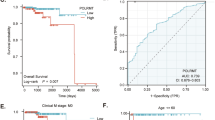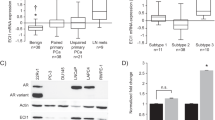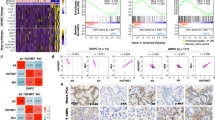Abstract
Prostate cancer progresses from an androgen-dependent to androgen-independent stage after androgen ablation therapy. Mitochondrial DNA plays a role in cell death and metastatic competence. Further, heteroplasmic large-deletion mitochondrial DNA is very common in prostate cancer. To investigate the role of mitochondrial DNA in androgen dependence of prostate cancers, we tested the changes of normal and deleted mitochondrial DNA in accordance with the progression of prostate cancer. We demonstrated that the androgen-independent cell line C4-2, established by inoculation of the androgen-dependent LNCaP cell line into castrated mice, has a greatly reduced amount of normal mitochondrial DNA and an accumulation of large-deletion DNA. Strikingly, the depletion of mitochondrial DNA from androgen-dependent LNCaP resulted in a loss of androgen dependence. Reconstitution of normal mitochondrial DNA to the mitochondrial DNA-depleted clone restored androgen dependence. These results indicate that mitochondrial DNA determines androgen dependence of prostate cancer cell lines. Further, mitochondrial DNA-deficient cells formed tumors in castrated athymic mice, whereas LNCaP did not. The accumulation of large deletion and depletion of mitochondrial DNA may thus play a role in the development of androgen independence, leading to progression of prostate cancers.
This is a preview of subscription content, access via your institution
Access options
Subscribe to this journal
Receive 50 print issues and online access
$259.00 per year
only $5.18 per issue
Buy this article
- Purchase on Springer Link
- Instant access to full article PDF
Prices may be subject to local taxes which are calculated during checkout






Similar content being viewed by others
References
Amuthan G, Biswas G, Zhang SY, Klein-Szanto A, Vijayasarathy C, Avadhani NG . (2001). EMBO J 20: 1910–1920.
Anderson S, Bankier AT, Barrell BG, de Bruijn MH, Coulson AR, Drouin J et al. (1981). Nature 290: 457–465.
Arnould T, Vankoningsloo S, Renard P, Houbion A, Ninane N, Demazy C et al. (2002). EMBO J 21: 53–63.
Biswas G, Adebanjo OA, Freedman BD, Anandatheerthavarada HK, Vijayasarathy C, Zaidi M et al. (1999). EMBO J 18: 522–533.
Burgart LJ, Zheng J, Shu Q, Strickler JG, Shibata D . (1995). Am J Pathol 147: 1105–1111.
Catz SD, Johnson JL . (2001). Oncogene 20: 7342–7351.
Chen JZ, Gokden N, Greene GF, Mukunyadzi P, Kadlubar FF . (2002). Cancer Res 62: 6470–6474.
Culig Z, Klocker H, Eberle J, Kaspar F, Hobisch A, Cronauer MV et al. (1993). Prostate 22: 11–22.
Diamond DA, Barrack ER . (1984). J Urol 132: 821–827.
Graff JR, Konicek BW, McNulty AM, Wang Z, Houck K, Allen S et al. (2000). J Biol Chem 275: 24500–24505.
Higuchi M, Aggarwal BB, Yeh ET . (1997). J Clin Invest 99: 1751–1758.
Higuchi M, Manna KS, Sasaki R, Aggarwal BB . (2002). Antioxidants Redox signal 4: 945–955.
Hirano M, Silvestri G, Blake DM, Lombes A, Minetti C, Bonilla E et al. (1994). Neurology 44: 721–727.
Horton TM, Petros JA, Heddi A, Shoffner J, Kaufman AE, Graham Jr SD et al. (1996). Genes Chromosomes Cancer 15: 95–101.
Huang S, Pettaway CA, Uehara H, Bucana CD, Fidler IJ . (2001). Oncogene 20: 4188–4197.
Jemal A, Murray T, Ward E, Samuels A, Tiwari RC, Ghafoor A et al. (2005). CA Cancer J Clin 55: 10–30.
Jeronimo C, Nomoto S, Caballero OL, Usadel H, Henrique R, Varzim G et al. (2001). Oncogene 20: 5195–5198.
Jessie BC, Sun CQ, Irons HR, Marshall FF, Wallace DC, Petros JA . (2001). Exp Gerontol 37: 169–174.
Kaukonen J, Juselius JK, Tiranti V, Kyttala A, Zeviani M, Comi GP et al. (2000). Science 289: 782–785.
Kawarada Y, Miura N, Sugiyama T . (1998). Jbiochem 123: 492–498.
Kimura K, Markowski M, Bowen C, Gelmann EP . (2001). Cancer Res 61: 5611–5618.
King MP, Attardi G . (1988). Cell 52: 811–819.
King MP, Attardi G . (1989). Science 246: 500–503.
Loeb LA . (2001). Cancer Res 61: 3230–3239.
McDonnell TJ, Troncoso P, Brisbay SM, Logothetis C, Chung LW, Hsieh JT et al. (1992). Cancer Res 52: 6940–6944.
Michikawa Y, Mazzucchelli F, Bresolin N, Scarlato G, Attardi G . (1999). Science 286: 774–779.
Nishigaki Y, Marti R, Hirano M . (2004). Hum Mol Genet 13: 91–101.
Nishigaki Y, Marti R, Copeland WC, Hirano M . (2003). J Clin Invest 111: 1913–1921.
Ozawa T . (1997). Physiol Rev 77: 425–464.
Palayoor ST, Youmell MY, Calderwood SK, Coleman CN, Price BD . (1999). Oncogene 18: 7389–7394.
Papadimitriou A, Comi GP, Hadjigeorgiou GM, Bordoni A, Sciacco M, Napoli L et al. (1998). Neurology 51: 1086–1092.
Petros JA, Baumann AK, Ruiz-Pesini E, Amin MB, Sun CQ, Hall J et al. (2005). Proc Natl Acad Sci USA 102: 719–724.
Rasmussen AK, Chatterjee A, Rasmussen LJ, Singh KK . (2003). Nucleic Acids Res 31: 3909–3917.
Ripple MO, Henry WF, Rago RP, Wilding G . (1997). J Natl Cancer Inst 89: 40–48.
Simonnet H, Alazard N, Pfeiffer K, Gallou C, Beroud C, Demont J et al. (2002). Carcinogenesis 23: 759–768.
Singh KK, Sigala B, Sikder HA, Schwimmer C . (2001). Nucleic Acids Res 29: 1381–1388.
Sommer A, Haendler B . (2003). Current Opinion in Drug Discovery & Development 6: 702–711.
Spelbrink JN, Li FY, Tiranti V, Nikali K, Yuan QP, Tariq M et al. (2001). Nature Genetics 28: 223–231.
Van Goethem G, Dermaut B, Lofgren A, Martin JJ, Van Broeckhoven C . (2001). Nat Genet 28: 211–212.
Wallace DC . (1992). Annu Rev Biochem 61: 1175–1212.
Washington MT, Rosenberg AH, Griffin K, Studier FW, Patel SS . (1996). J Biol Chem 271: 26825–26834.
Wu HC, Hsieh JT, Gleave ME, Brown NM, Pathak S, Chung LW . (1994). Int J Cancer 57: 406–412.
Zeviani M, Servidei S, Gellera C, Bertini E, DiMauro S, DiDonato S . (1989). Nature 339: 309–311.
Zhang D, Mott JL, Chang SW, Denniger G, Feng Z, Zassenhaus HP . (2000). Genomics 69: 151–161.
Acknowledgements
We thank Drs Tetsuo Ashizawa and Gordon B Mills for careful review of the manuscript. We thank Dr Yasuhisa Nakayama for his help in establishing long range PCR. We thank Dr Yutaka Nishigaki for his help in establishing Southern blotting. This work was supported by Charlotte Geyer Foundation, Taiho Pharmaceutical Co., Ltd, Tobacco Settlement at State of Arkansas and NIH grant RO1 CA100846 to M Higuchi.
Author information
Authors and Affiliations
Corresponding author
Rights and permissions
About this article
Cite this article
Higuchi, M., Kudo, T., Suzuki, S. et al. Mitochondrial DNA determines androgen dependence in prostate cancer cell lines. Oncogene 25, 1437–1445 (2006). https://doi.org/10.1038/sj.onc.1209190
Received:
Revised:
Accepted:
Published:
Issue Date:
DOI: https://doi.org/10.1038/sj.onc.1209190
Keywords
This article is cited by
-
Peroxiredoxin-3 is overexpressed in prostate cancer and promotes cancer cell survival by protecting cells from oxidative stress
British Journal of Cancer (2013)
-
Mitochondrial DNA depletion sensitizes cancer cells to PARP inhibitors by translational and post-translational repression of BRCA2
Oncogenesis (2013)
-
Consumption of oxygen: a mitochondrial-generated progression signal of advanced cancer
Cell Death & Disease (2012)
-
Mitochondrial DNA depletion in prostate epithelial cells promotes anoikis resistance and invasion through activation of PI3K/Akt2
Cell Death & Differentiation (2009)
-
Increased mitochondrial DNA induces acquired docetaxel resistance in head and neck cancer cells
Oncogene (2008)



